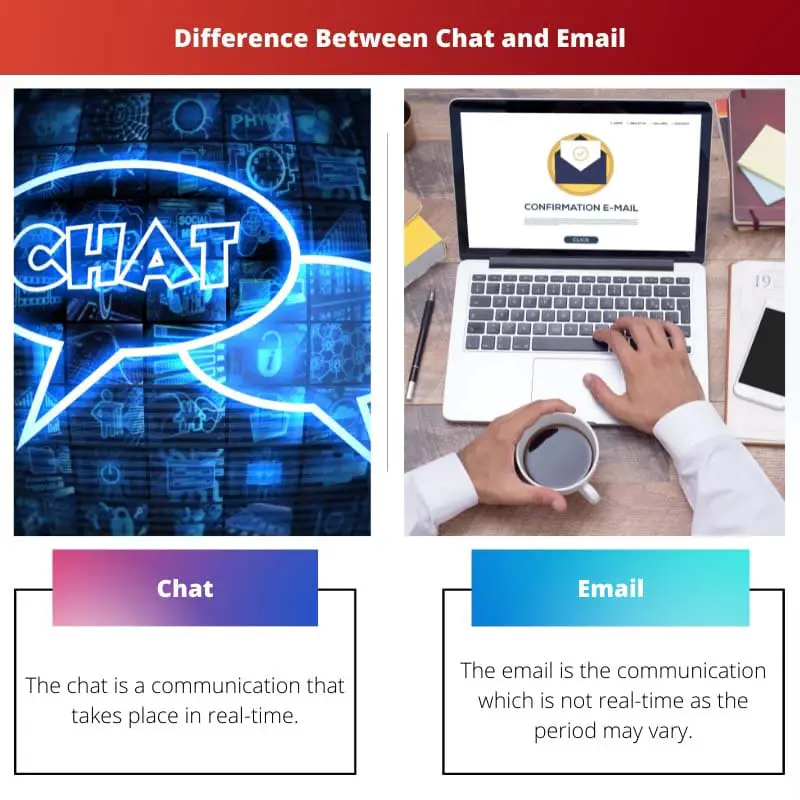Communication is very vital these days. Technology has advanced to a level where a person sitting on one continent can communicate with someone sitting on the other.
Chat and email are the ways by which we communicate. Both these methods require an internet connection. They have made communication very easy.
While chat and email have differences in many aspects, they both serve the agenda called communication.
Key Takeaways
- Chat allows for real-time, instant communication, used for informal conversations and quick exchanges of information.
- Email facilitates asynchronous communication, which is suitable for more formal and detailed exchanges.
- The choice between chat and email depends on the context and desired communication style.
Chat vs Email
The difference between chat and email is that email is used for professional purposes, whereas chat can be used for both professional and personal goals. The chat is real-time communication while the email is the communication, but the sender and receiver are replying at that time is not necessary. Usually, email is the method of direct communication used by people to share the io information with many people simultaneously. At the same time, the chat is between two people only.

The chat is real-time communication. The discussion can be done using various methods like Facebook, Instagram, and WhatsApp. Many other apps also provide the feature of conversation.
Even youtube has introduced a chat feature in it. The chat is a way of communication used for both personal and professional levels.
Email is the communication that is mainly used in touch at the professional level. The goggle introduces the email.
The email allows only 25MB of file transfer. More than that space can never be shared. The email is also helpful for transferring files saved in the cloud.
The email is an account of goggles, which can also be used to make accounts over other social media.
Comparison Table
| Parameters of Comparison | Chat | |
|---|---|---|
| Definition | Communication on email is never real-time. | The email is the communication which is not real-time as the period may vary. |
| Communication type | The communication type in the chat is in real-time. | The maximum data that can be shared over the chat is dependent on the app or platform we use. |
| Maximum data shared | A maximum of 25MB be shared over email the large files can be transferred by sharing the link of the cloud storage. | The voice, audio, apps, and pictures can be transmitted using the chat. |
| Types of data shared | The files are mainly pictures, and documents that are transferred using email. | The chat depends on the software like to chat over Facebook we require the Facebook messenger. |
| Dependent on | The email is not dependent on any software. | The email is not dependent on any kind of software. |
What is Chat?
The chat was first introduced in 1973, and the software used for the discussion was Talkomatic. Chat is a type of communication that is used in real-time.
The chat has made connecting with people from different areas, states, and countries easy.
Chat is the system that is used for the transferring of files across the internet. The documents, pictures, and audio files.
The size of the file being transferred through the chat depends on the platform we are using. Every platform, like Whatsapp, Facebook, and Twitter, has different data transfer conditions.
The chat is very innovative, but at the same time, it is also problematic. The discussion makes communication easy, but this increases the cases of harassment also.
The teenagers being naive and not much experienced, get easily trapped. This has given fuel to many crimes too.

What is Email?
The email was first introduced in 1971, and the goggle was the one that developed it. Email is the platform used mostly for professional uses, whereas it is also used for personal communication.
There is not any condition on the type of communication. The email is used as evidence among the companies or clients of the business.
Email is used to transfer the data over the internet, but only 25MB of the data can be shared if we are attaching the media. For large files, cloud storage links are used.
The email allows the teams to work together and update each other about any change that is taking place in the business.
If an email is sent in bulk to various emails and carries any advertisement, then the email is received in the spam folder. An email comes with many features.
The critical messages in the emails can be starred, and the important events can also be tasked. The email also keeps the events in the calendar, which helps remind the person about the event.

Main Differences Between Chat and Email
- The chat is real-time communication, whereas the email is not.
- Chat is mostly personal, while email is used mainly for professional communication.
- Chats are the communication that requires special software along with the accounts on those, whereas email is the platform that needs only one platform and account on the goggle.
- The chat requires an account on the same platform. Like if we are chatting via Facebook, then both person needs to have an account on Facebook, whereas email does not.
- The email can transfer a maximum of 25MB files, whereas in the chat, it depends on the platform used for the chat.


I concur, the thoroughness of the article is commendable.
I think the author’s focus was more on highlighting the features of chat and email rather than discussing their limitations.
I have to disagree. The historical context seemed somewhat tangential to the primary focus on the differences between chat and email.
The article could have been more detailed on the possible drawbacks of using each method of communication.
The article covered a wide range of aspects and features of chat and email, which made for an enlightening read.
I expected a more in-depth analysis of the historical context for the development of chat and email.
The author’s juxtaposition of the historical development of chat and email provided an engaging perspective on the evolution of communication technology.
I appreciate the concise historical context as it allowed for a focused and unbiased comparison.
The table provides a clear and systematic comparison between chat and email, helping the readers understand the differences better.
I thoroughly enjoyed the reading. The author provided an abundance of information about chat and email in a very clear and concise manner.
I disagree, the article’s level of detail was adequate.